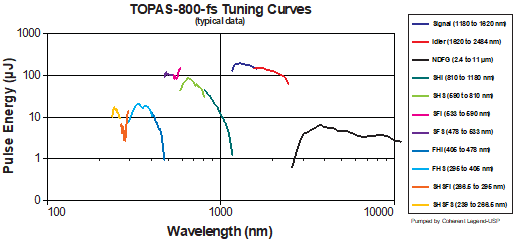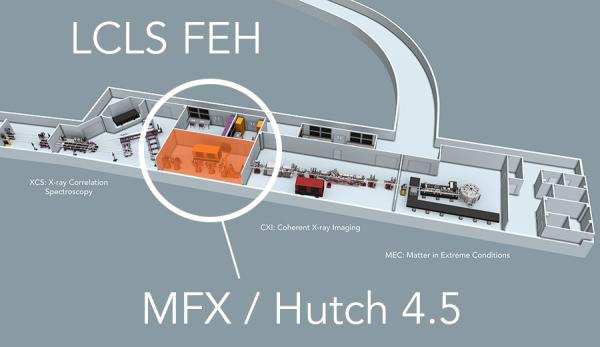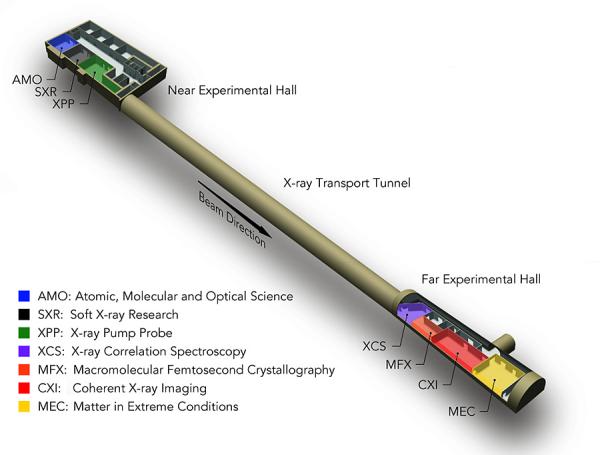MFX Standard Configurations
MFX Standard Configuration #1 for Run 25
#1 Helium Chamber for Vertical Liquid Jets
Types of Experiments
With this standard configuration, MFX supports jet-based Serial Femtosecond Crystallography (SFX) experiments at atmospheric pressure and temperature with noise minimization from the Helium environment. This will be possible with or without a pump laser. Also supported will be Small Angle and Wide Angle X-ray Scattering (SAXS/WAXS) with or without a pump laser using the wide variety of sample delivery jets, either LCLS-owned or supplied by the user groups. The detector will be an ePix10K-2.1M capable of 120 Hz operation or a Rayonix 340-XFEL capable of 30 Hz operation with 1920 x 1920 pixels frame size.
X-ray Focus
The incident photon energy is preferred to be 9.5 keV but justified deviations can be considered. The X-ray focus can vary over a range of ~3-4 µm to ~100 µm.
Sample Environment
A liquid jet chamber will be used. It is enclosed to provide a helium filled volume for the sample and the detector, including the following features that will be supported in this standard configuration.
Liquid Jet Mechanical System
The liquid jet mechanical system consists of an XYZ stage to position a nozzle inside the helium box. Any sample delivery system which is compatible with this mechanical system and the standard nozzle mount will be supported. This included Gas Dynamic Virtual Nozzle (GDVN), Lipidic Cubic Phase (LCP), the Microfluidic Electrokinetic Sample Holder (MESH) or other viscous extrusion systems, many types of mixing nozzles and any other system that can be mounted on the nozzle mount. Contact the MFX scientists for details on the nozzle rod and the injector mechanical system.
On-axis Sample Viewing System
The system at MFX will be equipped with an on-axis jet viewing system. This system provides a ~3 micron resolution view of the jet from the perspective of what the X-ray beam sees. This provides a rough alignment of the jet without any detailed information about the sample content or jet size and speed.
Perpendicular High Resolution Jet Imaging System
A high resolution jet imaging system will be installed to provide a perpendicular view of the jet. A continuous illumination will be used to provide the necessary illumination.
Pump Lasers
Time-resolved experiments employing tunable nanosecond and/or femtosecond pulses will be supported under this standard configuration. In the case that both nanosecond and femtosecond lasers are desired, the chosen wavelength will need to be compatible with the same optics set and should not require reconfiguration of the optical setup. While it is should not be expected that two lasers can be supported during a single experiment, a minimum required condition for this would be using only one of them at a time and switching between them during an off-shift if optics do not need to be modified.
Nanosecond Laser
An EKSPLA NL-204 Nd:YAG laser is available that can provide <8 ns pulses at 1064, 532, or 355 nm. Depending on the wavelength, the pulses can have energies of 1 - 4 mJ. It also has a repetition rate from 1 - 120 Hz. An Opolette HR 355 is also available for <8 ns pump laser pulses over a wide tunability range (410-2200 nm). Both laser systems propagate in free-space, but can be fiber-coupled. Note that the efficiency of the optics and the performance of the laser will not be the same for the entire wavelength range. The maximum achievable power density will be determined by the existing optical system and cannot be modified. Contact the MFX scientists to discuss specific needs and determine if they can be achieved using this standard configuration of the laser. The expected performance at the source is shown below (the energy on target will be substantially lower due to transport losses).
Femtosecond Laser
The fundamental (800 nm) or second harmonic (400 nm) of the ~50-150 fs Ti:Sapphire Coherent Astrella laser is also available. The system can also be used with a TOPAS-Prime Optical Parametric Amplifier (OPA) capable of 480-2400 nm wavelengths. Again, note that the efficiency of the optics and the performance of the laser and the OPA will not be the same for the entire wavelength range. The achievable peak intensity/fluence will be determined by the existing optical system and will not be modified. Contact the MFX scientists to discuss specific needs and to confirm whether they can be achieved in this standard configuration of the laser. The expected performance at the source is shown below. The approximate on target energy is shown below.

Timing Diagnostics
For the nanosecond laser, a fast diode will be available to verify the time overlap of the laser and the X-rays.
For the femtosecond laser, the MFX time tool will be available to record single shot arrival times that can be post-sorted. Time zero at the sample can be obtained to better than 200 fs using a MFX-supplied target to measure the index of refraction change induced by the x-ray beam.
Detector
The detector will be an ePix10K-2.1M capable of 120 Hz operation or a Rayonix 340-XFEL capable of 30 Hz operation with 1920 x 1920 pixels frame size. MFX is undergoing integration of a Jungfrau 16M which will be able to operate at 120 Hz with a 4000 x 4000 frame size of 75 µm pixels. It is anticipated this detector will be available this run but for more information about this detector please contact MFX Instrument Staff.
MFX Instrument Staff
Leland Gee, Daniel Rosenberg, Sebastian Dehe, Fred Poitevin, Sandra Mous, Greg Gate, Roberto Alonso-Mori, Andy Aquila, Mark Hunter, Meng Liang, Ray Sierra, Sebastien Boutet
Parameter Table
To be considered for scheduling in this standard configuration, users will be required to include a table in the proposal that lists the specific experimental parameters to ensure compatibility with these configurations. If the experimental parameters are not compatible with the standard configuration or if the table of parameters is incomplete, the proposal will be reviewed and considered for scheduling as general user proposal. Please see the table of required parameters. No fundamental changes to the standard configurations will occur, but some details of the configuration may be updated in response to inquiries, so users should recheck the website before submitting your proposal to confirm that you have the latest information. Address any questions to the instrument staff.
MFX Standard Configuration #2 for Run 25
#2 Vertical Liquid Jets and Fixed Targets in Air
Types of Experiments
With this standard configuration, MFX will support jet-based Serial Femtosecond Crystallography (SFX) experiments at atmospheric pressure and temperature in ambient air. This will be possible with or without a pump laser. Also supported will be Small Angle and Wide Angle X-ray Scattering (SAXS/WAXS) with or without a pump laser using the wide variety of sample delivery jets, either LCLS-owned or supplied by the user groups. This configuration will also support fixed target scanning. The detector will be an epix10K-2.1M capable of 120 Hz operation or a Rayonix 340-XFEL capable of 30 Hz operation with 1920 x 1920 pixels frame size.
X-ray Focus
The incident photon energy is preferred to be 9.5 keV but justified deviations can be considered. The X-ray focus can vary over a range of ~3-4 µm to ~100 µm.
Sample Environment
The following features that will be supported in this standard configuration.
Liquid Jet Mechanical System
The liquid jet mechanical system consists of an XYZ stage to position a nozzle inside the helium box. Any sample delivery system which is compatible with this mechanical system and the standard nozzle mount will be supported. This included Gas Dynamic Virtual Nozzle (GDVN), Lipidic Cubic Phase (LCP), the Microfluidic Electrokinetic Sample Holder (MESH) or other viscous extrusion systems, many types of mixing nozzles and any other system that can be mounted on the nozzle mount. Fixed target samples acan also be mounted on this system. Contact the MFX scientists for details on the nozzle rod and the injector mechanical system.
On-axis Sample Viewing System
The system will be equipped with an on-axis jet viewing system. This system provides a ~3 micron resolution view of the jet from the perspective of what the X-ray beam sees. This provides a rough alignment of the sample or the the jet without any detailed information about the sample content or jet size and speed.
Perpendicular High Resolution Jet Imaging System
A high resolution perpendicular sample/jet imaging system will be installed to provide a perpendicular view of the jet. A continuous illumination will be used to provide the necessary illumination.
Nanosecond Laser
An EKSPLA NL-204 Nd:YAG laser is available that can provide <8 ns pulses at 1064, 532, or 355 nm. Depending on the wavelength, the pulses can have energies of 1 - 4 mJ. It also has a repetition rate from 1 - 120 Hz. An Opolette HR 355 is also available for <8 ns pump laser pulses over a wide tunability range (410-2200 nm). Both laser systems propagate in free-space, but can be fiber-coupled. Note that the efficiency of the optics and the performance of the laser will not be the same for the entire wavelength range. The maximum achievable power density will be determined by the existing optical system and cannot be modified. Contact the MFX scientists to discuss specific needs and determine if they can be achieved using this standard configuration of the laser. The expected performance at the source is shown below (the energy on target will be substantially lower due to transport losses).
Femtosecond Laser
The fundamental (800 nm) or second harmonic (400 nm) of the ~50-150 fs Ti:Sapphire Coherent Astrella laser is available, delivered to the sample collinearly with the X-rays, with in-coupling ~250 mm upstream of the sample and with the focusing lens ~350 mm away from the sample. The system can also be used with a TOPAS-Prime Optical Parametric Amplifier (OPA) capable of 480-2400 nm wavelengths. Again, note that the efficiency of the optics and the performance of the laser and the OPA will not be the same for the entire wavelength range. The achievable peak intensity/fluence will be determined by the existing optical system and will not be modified. Contact the MFX scientists to discuss specific needs and to confirm whether they can be achieved in this standard configuration of the laser. The approximate on target energy is shown below.

Timing Diagnostics
For the nanosecond laser, a fast diode will be available to verify the time overlap of the laser and the X-rays.
For the femtosecond laser, the MFX time tool will be available to record single shot arrival times that can be post-sorted. Time zero at the sample can be obtained to better than 200 fs using a MFX-supplied target to measure the index of refraction change induced by the x-ray beam.
Detector
The detector will be an epix10K-2.1M capable of 120 Hz operation or a 340-XFEL capable of 30 Hz operation with 1920 x 1920 pixels frame size. MFX is undergoing integration of a Jungfrau 16M which will be able to operate at 120 Hz with a 4000 x 4000 frame size of 75 µm pixels. It is anticipated this detector will be available this run but for more information about this detector please contact MFX Instrument Staff.
MFX Instrument Staff
Leland Gee, Daniel Rosenberg, Sebastian Dehe, Fred Poitevin, Sandra Mous, Greg Gate, Mike Glownia, Roberto Alonso-Mori, Andy Aquila, Mark Hunter, Meng Liang, Ray Sierra, Sebastien Boutet
Parameter Table
To be considered for scheduling in this standard configuration, users will be required to include a table in the proposal that lists the specific experimental parameters to ensure compatibility with these configurations. If the experimental parameters are not compatible with the standard configuration or if the table of parameters is incomplete, the proposal will be reviewed and considered for scheduling as general user proposal. Please see the table of required parameters. No fundamental changes to the standard configurations will occur, but some details of the configuration may be updated in response to inquiries, so users should recheck the website before submitting your proposal to confirm that you have the latest information. Address any questions to the instrument staff.
MFX Standard Configuration #3 for Run 25
#3 Horizontal Liquid Jet Helium Chamber for Solution scattering or crystallography combined with emission spectroscopy
Types of Experiments
With this standard configuration, MFX will be able to support time-resolved wide-angle scattering or crystallography and X-ray emission measurements for the study of photo-excited molecular dynamics in the solution or crystalline phase. A Von Hamos spectrometer will be mounted above the sample to optimize the emission signal as a result of the new vertically polarized undulator.
The von Hamos spectrometer can cover the following X-ray emission lines: Mn Kß1,3, Kß2,5 and Kα, Fe Kß1,3 and Kß2,5, Co Kß1,3 and Kß2,5, Ni Kß1,3 and Kß2,5, Ti Kß1,3 and Kß2,5 and V Kα.
X-ray and X-ray Focus
Energies up to 25keV is now available. The MFX Instrument operates in pink mode. Refractive Be lenses will be available to deliver a beam size ranging from 3 to 200 μm at the sample. For experiments that don’t require specific photon energy and for scheduling purposes the default photon energy of 9.831 keV will be used for standard configuration.
Optical Pump Lasers
Time-resolved experiments employing tunable femtosecond pulses will be supported under this standard configuration. In addition to the 800/400 nm 50 fs Ti:Sapphire fundamental/2nd harmonic wavelengths, an OPA will be available to cover the wavelength range of 480-2400 nm. The optical pump beam will be propagating collinearly with the X-ray beam with <2 degree crossing angle. The pulse duration will be below 70 fs. We note that the efficiency of the optics and the performance of the laser and the OPA will not be the same for the entire wavelength range. The achievable peak intensity/fluence will be determined by the existing optical system and will not be modified. Contact the MFX scientists to discuss specific needs and to confirm whether they can be achieved in this standard configuration of the laser.
Timing diagnostics
The spectral-encoding based timing tool will be available to provide shot-to-shot jitter measurement. We expect a time resolution of 100 fs considering the pump/probe pulse duration as well as the jitter correction accuracy.
Sample Manipulation and Temperature Control
A helium purged sample chamber including sample monitoring and cleanup slits will be used to house the liquid jet, with Kapton windows to allow X-ray scattering and emission to be measured by detectors outside the chamber. A horizontal liquid jet driven by HPLC pumps will be used to deliver the sample into the interaction point.
Every user group accepted and scheduled to use the MFX standard configuration will be strongly advised to test the injection of their sample at the LCLS Sample Characterization Lab prior to the experiment.
Detectors
An ePix10k-2.1M detector will be mounted downstream of the chamber for the measurement of the forward scattering. The X-ray emission spectra will be measured by an ePix100 detector. MFX is undergoing integration of a Jungfrau 16M which will be able to operate at 120 Hz with a 4000 x 4000 frame size of 75 µm pixels. It is anticipated this detector will be available this run but for more information about this detector please contact MFX Instrument Staff.
MFX Instrument Staff
Leland Gee, Daniel Rosenberg, Sebastian Dehe, Fred Poitevin, Sandra Mous, Greg Gate, Mike Glownia, Roberto Alonso-Mori, Andy Aquila, Mark Hunter, Meng Liang, Ray Sierra, Sebastien Boutet
Parameter Table
To be considered for scheduling in this standard configuration, users will be required to include a table in the proposal that lists the specific experimental parameters to ensure compatibility with these configurations. If the experimental parameters are not compatible with the standard configuration or if the table of parameters is incomplete, the proposal will be reviewed and considered for scheduling as general user proposal. Please see the table of required parameters. No fundamental changes to the standard configurations will occur, but some details of the configuration may be updated in response to inquiries, so users should recheck the website before submitting your proposal to confirm that you have the latest information. Address any questions to the instrument staff.
MFX CONTACTS
Leland Gee
MFX Instrument Lead
(650) 926-3234
lbgee@slac.stanford.edu
Kelsey Banta
Area Manager
(650) 926-3819
hayes@slac.stanford.edu
Mark Hunter
BIO Department Head
(650) 926-6294
mhunter2@slac.stanford.edu
Roberto Alonso-Mori
Lead Scientist
(650) 926-4179
robertoa@slac.stanford.edu
Andy Aquila
Staff Scientist
(650) 926-2682
aquila@slac.stanford.edu
Sandra Mous
Associate Scientist
(650) 926-6225
smous@slac.stanford.edu
Fred Poitevin
Staff Scientist
(650) 926-5326
fpoitevi@slac.stanford.edu
Ray Sierra
Staff Scientist
(650) 926-3148
rsierra@slac.stanford.edu
Sebastian Dehe
Project Scientist
dehe@slac.stanford.edu
Greg Gate
Laser Scientist
(650) 926-2017
gate@slac.stanford.edu
Mike Glownia
Laser Scientist
(650) 926-5456
jglownia@slac.stanford.edu
James Baxter
Associate Scientist
(650) 926-5052
jb2717@slac.stanford.edu
Daniel Rosenberg
Associate Scientist
(650) 926-4740
djr@slac.stanford.edu
-
MFX Control Room
(650) 926-1745
MFX Hutch
(650) 926-1845
MFX LOCATION



